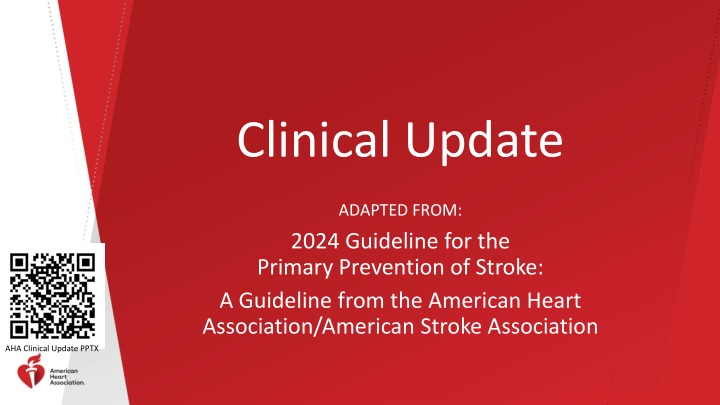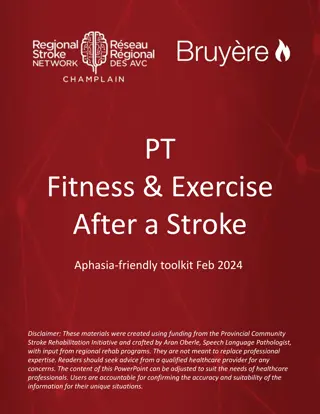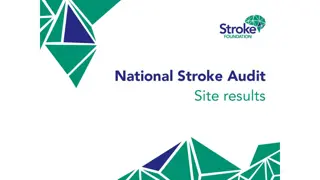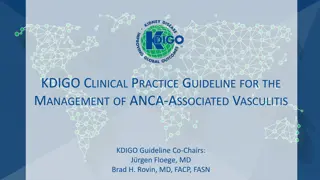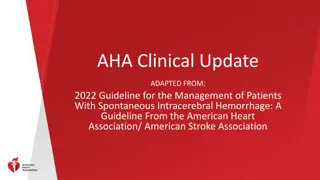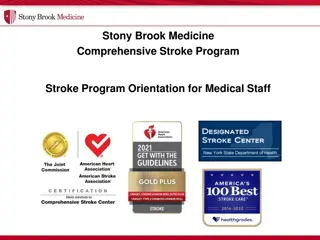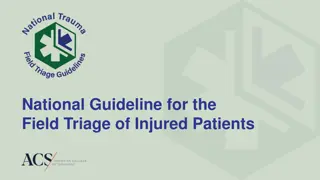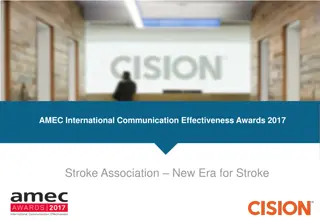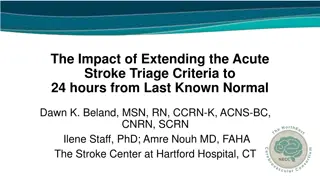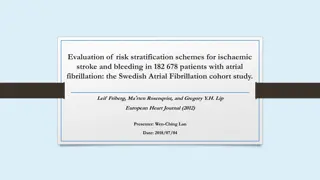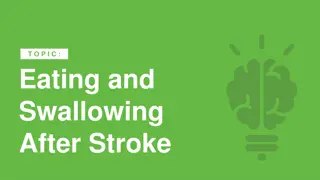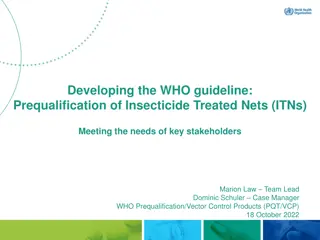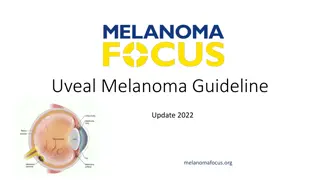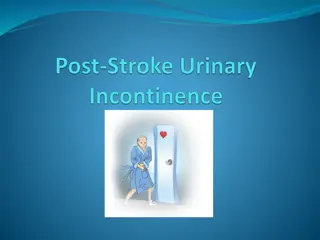Guideline for Primary Prevention of Stroke: Clinical Update 2024
This clinical update presents guidelines for the primary prevention of stroke based on the 2024 American Heart Association/American Stroke Association guidelines. It outlines different classes of recommendation levels and the quality of evidence supporting various clinical strategies, interventions, treatments, and diagnostic testing in patient care. The document categorizes recommendations ranging from strong (Class 1) to weak (Class 2b) based on the benefits versus risks and the quality of evidence from randomized controlled trials, meta-analyses, observational studies, and expert opinions. Recommendations cover treatment preferences, effectiveness, and potential harm, providing a comprehensive framework for healthcare professionals to make informed decisions in stroke prevention.
Download Presentation

Please find below an Image/Link to download the presentation.
The content on the website is provided AS IS for your information and personal use only. It may not be sold, licensed, or shared on other websites without obtaining consent from the author.If you encounter any issues during the download, it is possible that the publisher has removed the file from their server.
You are allowed to download the files provided on this website for personal or commercial use, subject to the condition that they are used lawfully. All files are the property of their respective owners.
The content on the website is provided AS IS for your information and personal use only. It may not be sold, licensed, or shared on other websites without obtaining consent from the author.
E N D
Presentation Transcript
Clinical Update ADAPTED FROM: 2024 Guideline for the Primary Prevention of Stroke: A Guideline from the American Heart Association/American Stroke Association AHA Clinical Update PPTX
CLASS (STRENGTH) OF RECOMMENDATION LEVEL (QUALITY) OF EVIDENCE Table 1. Applying Class of Recommendation and Level of Evidence to Clinical Strategies, Interventions, Treatments, or Diagnostic Testing in Patient Care CLASS 1 (STRONG) Benefit >>> Risk LEVEL A High-quality evidence from more than 1 RCT Meta-analyses of high-quality RCTs One or more RCTs corroborated by high-quality registry studies Suggested phrases for writing recommendations: Is recommended Is indicated/useful/effective/beneficial Should be performed/administered/other Comparative-Effectiveness Phrases : Treatment/strategy A is recommended/indicated in preference to treatment B Treatment A should be chosen over treatment B LEVEL B-R (Randomized) Moderate-quality evidence from 1 or more RCTs Meta-analyses of moderate-quality RCTs LEVEL B-NR (Nonrandomized) CLASS 2a (MODERATE) Benefit >> Risk Moderate-quality evidence from 1 or more well-designed, well- executed nonrandomized studies, observational studies, or registry studies Meta-analyses of such studies Suggested phrases for writing recommendations: Is reasonable Can be useful/effective/beneficial Comparative-Effectiveness Phrases : Treatment/strategy A is probably recommended/indicated in preference to treatment B It is reasonable to choose treatment A over treatment B LEVEL C-LD (Limited Data) Randomized or nonrandomized observational or registry studies with limitations of design or execution Meta-analyses of such studies Physiological or mechanistic studies in human subjects CLASS 2b (Weak) Benefit Risk Suggested phrases for writing recommendations: May/might be reasonable May/might be considered Usefulness/effectiveness is unknown/unclear/uncertain or not well- established LEVEL C-EO (Expert Opinion) A recommendation with LOE C does not imply that the recommendation is weak. Many important clinical questions addressed in guidelines do not lend themselves to clinical trials. Although RCTs are unavailable, there may be a very clear clinical consensus that a particular test or therapy is useful or effective. COR and LOE are determined independently (any COR may be paired with any LOE). Consensus of expert opinion based on clinical experience. CLASS 3: No Benefit (MODERATE) Benefit = Risk *The outcome or result of the intervention should be specified (an improved clinical outcome or increased diagnostic accuracy or incremental prognostic information). For comparative-effectiveness recommendation (COR 1 and 2a; LOE A and B only), studies that support the use of comparator verbs should involve direct comparisons of the treatments or strategies being evaluated. Suggested phrases for writing recommendations: Is not recommended Is not indicated/useful/effective/beneficial Should not be performed/administered/other The method of assessing quality is evolving, including the application of standardized, widely-used, and preferably validated evidence grading tools; and for systematic reviews, the incorporation of an Evidence Review Committee. COR indicates Class of Recommendation; EO, expert opinion; LD, limited data; LOE, Level of Evidence; NR, nonrandomized; R, randomized; and RCT, randomized controlled trial. CLASS 3: Harm (STRONG) Risk > Benefit Suggested phrases for writing recommendations: Bushnell, C., et al. 2024 Guideline for the Primary Prevention of Stroke: A Guideline From the American Heart Association/American Stroke Association. Stroke. Potentially harmful Causes harm Associated with excess morbidity/mortality Should not be performed/administered/other Bushnell, C., et al. 2024 Guideline for the Primary Prevention of Stroke: A Guideline From the American Heart Association/American Stroke Association. Stroke.
Elements Associated with Elevated Stroke Risk Adverse Social Determinants of Health Poor Access to Care Socioeconomic Disadvantage Lack of Social and Community Support Poor Access to Education Racism and Discrimination Inadequate Management of Common Risk Factors Undiagnosed Risk Factors Untreated Risk Factors Best Practices Not Followed Lack of Shared Decision Making Health System Barriers De-Emphasis of Lifestyle Factors (Life s Essential 8) Commonly Unrecognized Risk- enhancing Factors Lipoprotein(a) Thrombophilias Endometriosis Early Menopause Complications of Pregnancy Bushnell, C., et al. 2024 Guideline for the Primary Prevention of Stroke: A Guideline From the American Heart Association/American Stroke Association. Stroke. 3
Closing the Prevention Gap Prevention Gap: Difference between current and potential control of stroke risk factors in the US. Factors Affected: Lifestyle factors Medical factors that can be managed with behavior change and/or medication Non-medical factors including health literacy, food security, housing security, and access to medication Social determinant of health factors including access to education, access to health insurance, economic stability, neighborhood environment, and social and community context Importance: Represents the opportunity to reduce the burden of stroke on patients, communities, and society Presents modifiable factors that allow us to address disparities in stroke risk Underscores the imperative for quality improvement and health services research to improve risk factor detection and control Bushnell, C., et al. 2024 Guideline for the Primary Prevention of Stroke: A Guideline From the American Heart Association/American Stroke Association. Stroke. 4
Sources of Evidence Used in Prevention Recommendations in this Guideline Outcome data from research in populations: Without CVD With CVD but not any Stroke or TIA With CVD but 50% with history of stroke Abbreviations: CVD indicates cardiovascular disease; and TIA, transient ischemic attach. Bushnell, C., et al. 2024 Guideline for the Primary Prevention of Stroke: A Guideline From the American Heart Association/American Stroke Association. Stroke. 5
Social Determinants of Health and Health-Related Social Needs Economic Stability Health Literacy Education Food Security Healthcare Access Experiences of Racism Housing Security Bushnell, C., et al. 2024 Guideline for the Primary Prevention of Stroke: A Guideline From the American Heart Association/American Stroke Association. Stroke. 6
Primary Prevention: Screening COR RECOMMENDATIONS In persons aged 40-79 years, estimations of risk for CVD every 1-5 years is beneficial to guide decisions on treatments and lifestyle recommendations that may reduce risk for stroke. 1 In persons with AF, calculations of CHA2DS2-VASc score is recommended to guide decisions on prescription of oral anticoagulation to reduce risk for stroke. 1 In persons aged 18 or greater, periodic screening for modifiable behaviors and medical conditions that increase stroke risk is recommended. 1 In persons aged 18 and up, periodic screening for SDoH is beneficial to identify additional factors which contribute to stroke risk. 1 Abbreviations: CVD indicates cardiovascular disease; and SDoH , social determinants of health. Bushnell, C., et al. 2024 Guideline for the Primary Prevention of Stroke: A Guideline From the American Heart Association/American Stroke Association. Stroke. 7
Management of Health Behaviors and Health Factors for Primary Prevention of Stroke Diet Quality COR RECOMMENDATIONS In adults without prior CVD and who are at high or intermediate CVD risk, a Mediterranean diet is recommended to reduce the risk of incident stroke. 1 In adults who are aged 60 years or older and have uncontrolled BP, compared to using 100% sodium chloride, salt substitution is reasonable to reduce the risk of incident stroke. 2a In adults, folic acid supplementation and B-complex vitamins supplementation for reducing the risk of stroke is not well- established. 2b In adults without prior CVD, long-chain fatty acids are not effective for reducing the risk of stroke. 3: No Benefit In adults, vitamin C, vitamin E, selenium, antioxidants, calcium, calcium with vitamin D, and multivitamin supplementation are not effective for reducing the risk of stroke. 3: No Benefit Abbreviations: BP indicates blood pressure; and CVD, cardiovascular disease. Bushnell, C., et al. 2024 Guideline for the Primary Prevention of Stroke: A Guideline From the American Heart Association/American Stroke Association. Stroke. 8
Management of Health Behaviors and Health Factors for Primary Prevention of Stroke Physical Activity COR RECOMMENDATIONS In adults, screening for physical activity is recommended to estimate stroke risk. 1 In adults, counseling patients to get at least 150 minutes of moderate intensity or 75 minutes of vigorous intensity physical activity per week is recommended to reduce stroke risk. 1 In adults, counseling to avoid excessive time spent in sedentary behavior is recommended to reduce stroke risk. 1 Bushnell, C., et al. 2024 Guideline for the Primary Prevention of Stroke: A Guideline From the American Heart Association/American Stroke Association. Stroke. 9
Management of Health Behaviors and Health Factors for Primary Prevention of Stroke Blood Sugar COR RECOMMENDATIONS In asymptomatic adults aged 18 or over, who have overweight, obesity , or ASCVD, screening for diabetes is recommended to inform stroke risk. 1 In patients with diabetes and high CV risk or established CVD, treatment with a GLP-1 receptor agonist is effective to reduce the risk of stroke. 1 In patients with T1D or T2D, intensive glycemic control is not beneficial for stroke prevention. 3: No Benefit Abbreviations: ASCVD indicates atherosclerotic cardiovascular disease; CV, cardiovascular; CVD, cardiovascular disease; GLP-1, glucagon-like protein-1; T1D, type 1 diabetes mellitus; and T2D, type 2 diabetes mellitus. Bushnell, C., et al. 2024 Guideline for the Primary Prevention of Stroke: A Guideline From the American Heart Association/American Stroke Association. Stroke. 10
Management of Health Behaviors and Health Factors for Primary Prevention of Stroke Weight and Obesity COR RECOMMENDATIONS In adults over age 18, screening for overweight and obesity is recommended to inform the risk of stroke. 1 In patients with Obesity Class II and above, bariatric surgical procedures to promote weight loss may be considered to reduce the risk of stroke. 2b Bushnell, C., et al. 2024 Guideline for the Primary Prevention of Stroke: A Guideline From the American Heart Association/American Stroke Association. Stroke. 11
Management of Health Behaviors and Health Factors for Primary Prevention of Stroke Lipids COR RECOMMENDATIONS In adults who qualify for treatment with lipid- lowering therapy according the AHA guidelines, treatment with a statin is recommended to reduce the risk of a first stroke. 1 Patients without CVD who are treated with lipid- lowering therapy, according to AHA guidelines, who cannot reach goals with statins, the benefit ofalirocumab or evolocumab has not been proven for stroke risk reduction. 2b In adults who do not tolerate statin therapy and have elevated LDL-C and increased CV risk, treatment bempedoic acid has not been proven to reduce risk of stroke. 2b In adults in moderate or low intake of long chain omega-3 fatty acid is not recommended to reduce the risk of a first stroke. 3: No Benefit Abbreviations: AHA indicates the American Heart Association ; CV, cardiovascular; CVD, cardiovascular disease; and LDL-C, low-density lipoprotein cholesterol. Bushnell, C., et al. 2024 Guideline for the Primary Prevention of Stroke: A Guideline From the American Heart Association/American Stroke Association. Stroke. 12
Management of Health Behaviors and Health Factors for Primary Prevention of Stroke Blood Pressure COR RECOMMENDATIONS In adults aged 18 or over, screening for hypertension is recommended to identify stroke risk and eligibility for treatment. 1 In adults with stage 1 or stage 2 hypertension, lifestyle modification and drug treatment to a BP less than 130/80 is recommended to reduce stroke risk. 1 In adults with HTN, thiazide and thiazide like diuretics, CCB, ACEI, and ARBs are recommended as initial therapies to reduce stroke risk. 1 In adults with HTN, drug therapy with one or more medications is indicated to reach BP control necessary to prevent stroke. 1 Abbreviations: ACEI indicates angiotensin converting enzyme inhibitor; ARB, angiotensin receptor blocker; BP, blood pressure; CCB, calcium channel blocker; and HTN, hypertension. Bushnell, C., et al. 2024 Guideline for the Primary Prevention of Stroke: A Guideline From the American Heart Association/American Stroke Association. Stroke. 13
Management of Health Behaviors and Health Factors for Primary Prevention of Stroke Tobacco Use / Cessation Intervention COR RECOMMENDATIONS For active smokers, cessation medication delivered with behavioral counseling is recommended. 1 For active smokers of cigarettes and other tobacco products assistance with cessation is recommended to reduce the risk of stroke. 1 For active smokers who are in a hospital setting, cessation medications alongside behavioral counseling is reasonable for smoking cessation. 2a For active smokers, the long-term health benefits of using e-cigarettes in place of nicotine replacement therapy for smoking cessation is not well-established. 2b Bushnell, C., et al. 2024 Guideline for the Primary Prevention of Stroke: A Guideline From the American Heart Association/American Stroke Association. Stroke. 14
Management of Health Behaviors and Health Factors for Primary Prevention of Stroke Tobacco Use / Cessation Intervention Sleep COR RECOMMENDATIONS The effectiveness of screening adults for obstructive sleep apnea to prevent stroke is unclear. 2b In patients with obstructive sleep apnea, continuous positive airway pressure might be reasonable to reduce the risk of stroke. 2b Bushnell, C., et al. 2024 Guideline for the Primary Prevention of Stroke: A Guideline From the American Heart Association/American Stroke Association. Stroke. 15
Atherosclerotic and Non-Atherosclerotic Risk Factors: Asymptomatic Carotid Artery Stenosis RECOMMENDATIONS 3: In the asymptomatic population, routine screening for carotid artery stenosis is not recommended to reduce the risk of stroke. No Benefit In patients with asymptomatic carotid artery stenosis >70%,shared decision-making between the patient and the health care team to decide between carotid revascularization or medical management is recommended. 1 In patients with asymptomatic atherosclerotic carotid artery stenosis, medical treatment with statins can be beneficial to reduce the risk of stroke. 2a In patients with asymptomatic atherosclerotic carotid artery stenosis >70% and low perioperative risk, the use of carotid revascularization, in addition to intensive medical therapy, may be reasonable to reduce the risk of stroke. 2b In patients with asymptomatic carotid artery stenosis >50%, annual carotid duplex ultrasound might be reasonable to assess progression of disease and subsequent increased risk of stroke. 2b In patients with asymptomatic atherosclerotic carotid artery stenosis and high perioperative risk, the effectiveness of carid revascularization to reduce stroke risk is not established. 2b Bushnell, C., et al. 2024 Guideline for the Primary Prevention of Stroke: A Guideline From the American Heart Association/American Stroke Association. Stroke. 16
Atherosclerotic and Non-Atherosclerotic Risk Factors: Asymptomatic Cerebral Small Vessel Disease COR RECOMMENDATIONS In adults with asymptomatic cerebral small vessel disease, including silent infarcts, assessment and management of risk factors is recommended to reduce stroke risk. 1 In adults with silent cerebral infarcts who do not have an indication for statin therapy, use of low-dose statin therapy might be considered to reduce the risk of ischemic stroke. 2b In adults with silent cerebral infarcts, the benefit of antiplatelet therapy to reduce the risk of ischemic stroke is uncertain. 2b Bushnell, C., et al. 2024 Guideline for the Primary Prevention of Stroke: A Guideline From the American Heart Association/American Stroke Association. Stroke. 17
Atherosclerotic and Non-Atherosclerotic Risk Factors: Migraine Linking Migraine to Stroke: An association between migraine, particularly migraine with aura, and stroke risk has been consistently identified in observational studies. This association is stronger for ischemic stroke than for hemorrhagic stroke and is more evident in young women. Vascular risk factors are common in patients with migraine and contribute to excess stroke risk. Use of combined hormonal contraception in those with migraine with aura is associated with increased risk for ischemic stroke. Bushnell, C., et al. 2024 Guideline for the Primary Prevention of Stroke: A Guideline From the American Heart Association/American Stroke Association. Stroke. 18
Atherosclerotic and Non-Atherosclerotic Risk Factors: Migraine COR RECOMMENDATIONS In adults aged 18-64 years with migraine with or without aura, evaluation and modification of vascular risk factors is recommended, to address the elevated risk of stroke. 1 In adults with migraine with aura who desire contraception, progestin-only or non-hormonal forms are recommended to avoid the increased risk of ischemic stroke associated with combined hormonal contraception. 1 Bushnell, C., et al. 2024 Guideline for the Primary Prevention of Stroke: A Guideline From the American Heart Association/American Stroke Association. Stroke. 19
Stroke Prevention in Children with Sickle Cell Disease Ages 2-16 Screening Intervention Brain MRI without Sedation COR RECOMMENDATIONS COR RECOMMENDATIONS TCD screening frequency based on the highest mean flow velocity in the terminal portion of the internal carotid, or the proximal portion of the middle cerebral artery is recommended. Should be performed as soon as possible in children and young adults with SCD and Beta-Thalassemia to evaluate for SCI and determine the need for chronic transfusions for stroke prevention. 1 2a Abbreviations: SCD indicates sickle cell disease; SCI, silent cerebral infarcts/infarction; and TCD, transcranial Doppler. Bushnell, C., et al. 2024 Guideline for the Primary Prevention of Stroke: A Guideline From the American Heart Association/American Stroke Association. Stroke. 20
Stroke Prevention in Children with Sickle Cell Disease Ages 2-16 Other Interventions COR RECOMMENDATIONS If considered at high risk based on TCD measurements, regularly scheduled transfusion therapy is effective for reducing stroke risk. 1 If TCD velocities revert to normal, continued transfusion therapy can be beneficial to reduce the stroke risk. 2a If mean flow velocities normalize and no intracranial stenosis is present, transitioning from transfusion to hydroxyurea therapy can be considered for stroke prevention. 2a If stroke risk for stroke is high without intracranial stenosis and transfusion therapy is contraindicated, then hydroxyurea or bone marrow transplantation may be reasonable for stroke prevention. 2b Abbreviations: TCD indicates transcranial doppler. Bushnell, C., et al. 2024 Guideline for the Primary Prevention of Stroke: A Guideline From the American Heart Association/American Stroke Association. Stroke. 21
Genetic Stroke Syndromes COR RECOMMENDATIONS In patients with CADASIL, counseling on smoking cessation and treatment of hypertension and other vascular risk factors is beneficial to reduce the risk of incident stroke. 1 In adults with hereditary hemorrhagic telangiectasia, screening for pulmonary arteriovenous malformations is reasonable to identify the need for multidisciplinary evaluation to manage stroke risk 2a In patients with Fabry disease, the effectiveness of enzyme replacement therapy to reduce the risk of stroke is not well established. 2b Abbreviations: CADASIL indicates Cerebral Autosomal Dominant Arteriopathy with Subcortical Infarcts and Leukoencephalopathy. Bushnell, C., et al. 2024 Guideline for the Primary Prevention of Stroke: A Guideline From the American Heart Association/American Stroke Association. Stroke. 22
Inflammation in Atherosclerosis COR RECOMMENDATIONS In adults with a recent MI, the addition of low dose colchicine to intensive statin therapy might be reasonable to decrease the risk of ischemic stroke 2b Abbreviations: CAD indicates coronary artery disease; and MI, myocardial infarction. Bushnell, C., et al. 2024 Guideline for the Primary Prevention of Stroke: A Guideline From the American Heart Association/American Stroke Association. Stroke. 23
Stroke Prevention in Autoimmune Disorders: Antiphospholipid Syndrome (APS) and Systemic Lupus Erythematosus (SLE) Hx of APS with Pregnancy Only SLE High-Risk aPL profile Patients with APS No Hx of stroke No indication for anticoagulation In non-pregnant adults History of venous thrombosis No history of thrombosis or pregnancy complications High-Risk aPL profile Low-Risk aPL profile Aspirin It is reasonable to choose a Vitamin K agonist over DOAC or Aspirin for prevention of recurrent thrombotic events, including stroke (Class 2a) Aspirin may be considered (Class 2b) Recommended (Class 1a) Aspirin Recommende d (Class 1a) Aspirin may be considered (Class 2b) Abbreviations: aPL indicates antiphospholipid antibodies; APS, autoimmune condition characterized by the presence of venous or arterial thrombosis and/or pregnancy-related complications in patients with antiphospholipid antibodies; DOAC, direct oral anticoagulant; Hx, history; and SLE, systemic lupus arthritis. Bushnell, C., et al. 2024 Guideline for the Primary Prevention of Stroke: A Guideline From the American Heart Association/American Stroke Association. Stroke. 24
Stroke Prevention in Autoimmune Disorders: Rheumatoid Arthritis Patients with rheumatoid arthritis SLE Patients with APS Statin treatment may be reasonable for stroke prevention (Class 2b) Bushnell, C., et al. 2024 Guideline for the Primary Prevention of Stroke: A Guideline From the American Heart Association/American Stroke Association. Stroke. 25
Stroke Prevention Related to Infections COR RECOMMENDATIONS In patients with periodontal disease, good oral hygiene and regular dental care can be beneficial to lower stroke risk. 2a In patients hospitalized with COVID- 19, treatment with full-dose anticoagulation is not recommended to prevent stroke. 3: No Benefit Bushnell, C., et al. 2024 Guideline for the Primary Prevention of Stroke: A Guideline From the American Heart Association/American Stroke Association. Stroke. 26
Stroke Prevention in Substance Use Disorders COR RECOMMENDATIONS In all adults, screening for substance misuse and substance use disorders is recommended to inform stroke risk. 1 In patients who use recreational drugs or misuse alcohol or prescription medications or have a substance use disorder, counseling to stop, or appropriate substance use disorder treatments as appropriate is reasonable to reduce stroke risk. 2a Bushnell, C., et al. 2024 Guideline for the Primary Prevention of Stroke: A Guideline From the American Heart Association/American Stroke Association. Stroke. 27
Prevention of Pregnancy-Associated Stroke In patients with hypertensive disorders of pregnancy, including chronic hypertension in pregnancy, treatment with antihypertensive medication to a goal BP of <140/90 mmHg is reasonable to reduce the risk of pregnancy-associated stroke. (Class 2a) In pregnant or early postpartum (within 6 weeks of delivery) patients with severe hypertension, BP-lowering treatment to a target <160/110 mmHg as soon as possible is recommended to reduce the risk of fatal maternal ICH. (Class 1) Abbreviations: BP indicates Blood Pressure; and ICH, Intracranial Hemorrhage. Bushnell, C., et al. 2024 Guideline for the Primary Prevention of Stroke: A Guideline From the American Heart Association/American Stroke Association. Stroke. 28
Prevention of Stroke in Women at Increased Risk because of Pregnancy Events Patient Without History of Stroke Screening for a history of certain adverse pregnancy outcomes, including hypertensive disorders of pregnancy, preterm birth, gestational diabetes, and placental disorders, followed by subsequent evaluation and management of vascular risk factors, is recommended to reduce the risk of stroke (Class 1) Yes Have you ever been pregnant? No Conclude Screening How many pregnancies were affected by a miscarriage? Answer: 1 Answer: 2 How many pregnancies were affected by: preterm birth high blood pressure (including postpartum) small for gestational age gestational diabetes (which resolved after pregnancy) placental abruption fetal death (stillborn) Answer Options of 0 or 1 for each condition. Evaluation and management of vascular risk factors (Class 1) Answer: 1 Answer: 0 Bushnell, C., et al. 2024 Guideline for the Primary Prevention of Stroke: A Guideline From the American Heart Association/American Stroke Association. Stroke. 29
Endometriosis Increases the Risk of Future Stroke COR RECOMMENDATIONS Positive History of Endometriosis increases the risk of: Screening for Endometriosis history is reasonable to inform the risk of stroke POSITIVE HISTORY 2a Stroke Vascular risk factor evaluation and modification of vascular risk factors are reasonable to reduce stroke risk. Hypertension 2a Hypercholesterolemia Inflammation Cardiovascular Disease Bushnell, C., et al. 2024 Guideline for the Primary Prevention of Stroke: A Guideline From the American Heart Association/American Stroke Association. Stroke. 30
Stroke Risk with Hormonal Contraception In individuals with specific stroke risk factors considering contraception* Patient considering combined hormonal contraception? Shared decision making is recommended to determine best choice to balance stroke risk from contraception vs. stroke risk with pregnancy (Class 1) Lower doses of ethinyl estradiol are recommended to minimize potential increased stroke risk (Class 1) Progestin only or non- hormonal contraception is reasonable to prevent the increased risk of stroke (Class 2a) * i.e., age >35 years, tobacco use, hypertension, or migraine with aura Bushnell, C., et al. 2024 Guideline for the Primary Prevention of Stroke: A Guideline From the American Heart Association/American Stroke Association. Stroke. 31
Menopause Associated Stroke Risk Reduction COR RECOMMENDATIONS Screening for a history of premature ovarian failure or premature early menopause can be beneficial to inform stroke risk. 1 In patients with premature ovarian failure or early menopause, evaluation and modification of vascular risk factors is recommended to reduce elevated stroke risk. 1 In women aged 60 years or older, or more than 10 years post-natural-menopause, or at elevated risk for CVD or stroke, oral estrogen- containing menopausal hormone therapy is associated with an excess risk of stroke and must be weighed against clinical benefits. 3: Harm Abbreviations: MHT indicates menopausal hormonal treatment. Bushnell, C., et al. 2024 Guideline for the Primary Prevention of Stroke: A Guideline From the American Heart Association/American Stroke Association. Stroke. 32
Menopause Associated Stroke Risk Reduction Woman with moderate to severe vasomotor symptoms: hot flashes, night sweats or both Assess for contraindications to menopausal hormone therapy use: history of breast cancer, liver disease, history of myocardial infarction, known or suspected estrogen-dependent neoplasia, history of deep vein thrombosis, thrombophilic disorders Contraindictions Present No Contraindictions Selection of menopausal hormone therapy preparation with Shared Decision-Making: Consider alternative non-hormonal therapy Ideal candidate for starting MHT: 1. Younger than 60 years 2. Within 10 years since menopause onset 3. No elevated risk for cardiovascular disease, stroke, or breast cancer Oral formulations: If previous hysterectomy Estrogen only If uterus intact Estrogen plus progesterone or bazedoxifine Transdermal formulations: No increased risk of stroke with low-dose estrogen vs high-dose transdermal or oral estrogen Monitor for abnormal vaginal bleeding and endometrial hyperplasia during MHT use Abbreviations: MHT indicates menopausal hormonal treatment. Bushnell, C., et al. 2024 Guideline for the Primary Prevention of Stroke: A Guideline From the American Heart Association/American Stroke Association. Stroke. 33
Hormone use and Stroke Risk Reduction COR RECOMMENDATIONS In transgender women and gender-diverse individuals taking estrogens for gender affirmation, evaluation and modification of risk factors can be beneficial to reduce stroke risk. 2a In men aged 45-80 with confirmed hypogonadism who are considering testosterone therapy, initiation or continuation of testosterone replacement therapy is reasonable and does not increase stroke risk. 2a Bushnell, C., et al. 2024 Guideline for the Primary Prevention of Stroke: A Guideline From the American Heart Association/American Stroke Association. Stroke. 34
Cardiomyopathy and Stroke Risk Reduction Anticoagulation Use for Primary Prevention of Stroke in Cardiomyopathy COR RECOMMENDATIONS In patients with left ventricular systolic dysfunction and no evidence of AF or left ventricular thrombus, anticoagulation is not indicated to prevent stroke and is associated with a higher bleeding risk. 3: No Benefit Abbreviations: AF indicates atrial fibrillation. Bushnell, C., et al. 2024 Guideline for the Primary Prevention of Stroke: A Guideline From the American Heart Association/American Stroke Association. Stroke. 35
Antiplatelet Use for Primary Prevention of Stroke No prior stroke or transient ischemic attack Established stable CAD? No Yes In individuals aged 70 years, with at least one additional cardiovascular risk factor, the use of aspirin is not beneficial to prevent a first stroke. (Class 3: No benefit) In patients with diabetes or other common vascular risk factors and no prior stroke, the use of aspirin to prevent a first stroke is not well established. (Class 2b) In patients with established, stable coronary artery disease and a low bleeding risk, the addition of ticagrelor to aspirin beyond 12 months for a period up to 3 years may be beneficial to reduce the rate of ischemic stroke. (Class 2b) In patients with chronic kidney disease, the use of aspirin is not effective to prevent a first stroke. (Class 3: No benefit) Abbreviations: CAD indicates coronary artery disease. Bushnell, C., et al. 2024 Guideline for the Primary Prevention of Stroke: A Guideline From the American Heart Association/American Stroke Association. Stroke. 36
Acknowledgments Many thanks to our Guideline Ambassadors who were guided by Dr. Elliott Antman in developing this translational learning product in support of the 2024 Guideline for the Primary Prevention of Stroke: A Guideline from the AHA/ASA. Dr. Michael Aljadah Dr. Nnamdi Azih Dr. Gene Hu Dr. Belal Suleiman Dr. Ashely Williams The American Heart Association requests this electronic slide deck be cited as follows: Aljadah, M., Azih, N., Hu, G., Suleiman, B., Williams, A., Reyna, G.G., Bezanson, J. L., & Antman, E. M. (2024). AHA Clinical Update; Adapted from: [PowerPoint slides]. Retrieved from the 2024 AHA/ASA Guideline for the Primary Prevention of Stroke: A Guideline from the AHA/ASA. https://professional.heart.org/en/science-news . Bushnell, C., et al. 2024 Guideline for the Primary Prevention of Stroke: A Guideline From the American Heart Association/American Stroke Association. Stroke. 37
